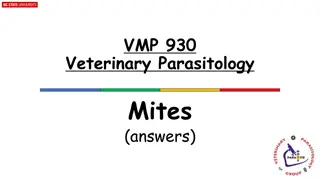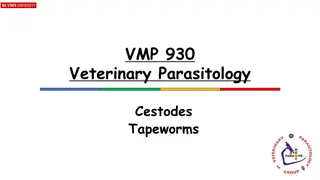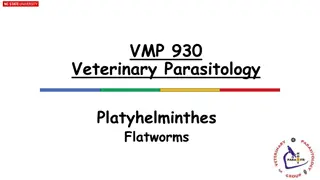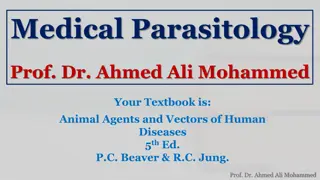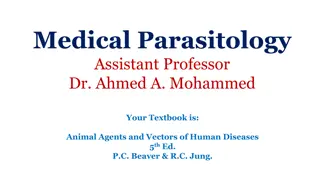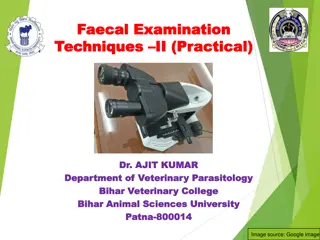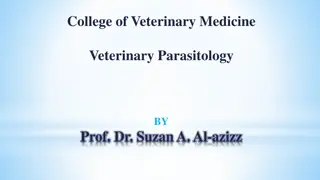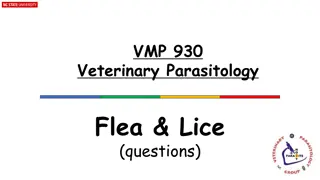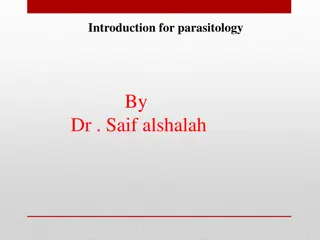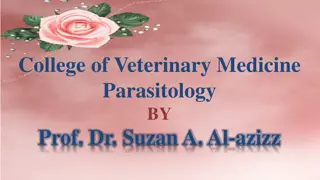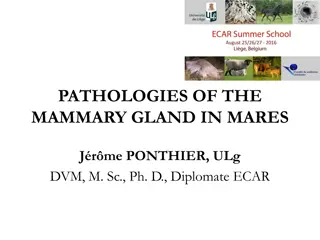Veterinary Parasitology Flies: Identification and Pathologies
This content covers information related to veterinary parasitology focusing on flies, their scientific names, common names, characteristics, and pathologies associated with them. It also includes details on types of myiasis, bot characteristics, and filth fly characteristics, providing a comprehensive overview for veterinary professionals and students.
Download Presentation

Please find below an Image/Link to download the presentation.
The content on the website is provided AS IS for your information and personal use only. It may not be sold, licensed, or shared on other websites without obtaining consent from the author.If you encounter any issues during the download, it is possible that the publisher has removed the file from their server.
You are allowed to download the files provided on this website for personal or commercial use, subject to the condition that they are used lawfully. All files are the property of their respective owners.
The content on the website is provided AS IS for your information and personal use only. It may not be sold, licensed, or shared on other websites without obtaining consent from the author.
E N D
Presentation Transcript
VMP 930 Veterinary Parasitology Flies (answers)
Fly Names Match fly scientific name with common name ___ 1. Cuterebra sp. C D A. Face Fly B. Horn Fly C. Rodent Bot D. Stable Fly E. Sheep Nasal Bot F. Heel Fly ___ 2. Stomoxys calcitrans F ___ 3. Hypoderma spp. E ___ 4. Oestrus ovis B ___ 5. Haematobia irritans A ___ 6. Musca autumnalis
Flies: Fill-in-the-Blank Decreased thriftiness Decreased weight gain to weight loss Low productivity (ex. Milk) Low feed conversion 1. List one potential pathology of Fly-bother _________________ Myiasis 2. _________________ is the invasion of tissue by dipterous larvae (maggots or bots). 3. Regarding Hypoderma spp. What is the danger of waiting too long to treat for this bot? Post-treatment pathology: Paralysis or Fatal Bloat _________________________________________________________________________________ A. Haematobia & Cuterebra B. Gasterophilus & Oestrus 4. Multiple Choice (pick 2): Which 2 flies, which cause myiasis, are treated by mechanical / surgical removal ? _______ D C. Hypoderma & Stomoxys D. Cuterebra & Phormia
Filth Fly Characteristics Match fly with characteristics (there may be more than one correct answer) A, D _____ 1. Breeding Habitat: Rotting Vegetation B, C A. Musca domestica B. Musca autumnalis C. Haematobia irritans D. Stomoxys calcitrans _____ 2. Breeding Habitat: Fresh Cow Feces A, B _____ 3. Sponging Mouth Parts C, D _____ 4. Feeds on Blood B, C _____ 5. In-feed insecticides _____ 6. Congregates on Back of Cattle C B _____ 7. Keratoconjunctivitis (Moraxella bovis)
Types of Myiasis Match fly with Type of Myiasis (there may be more than one correct answer) B _____ 1. Secondary Screwworm (Cochliomyia macellaria) _____ 2. Rodent Bot (Cuterebra emasculator) A A. Obligate Myiasis B. Facultative Myiasis B _____ 3. Black Blow Fly (Phormia regina) A _____ 4. Primary screwworm (Cochliomyia hominivorax) B _____ 5. Blue Bottle Fly (Calliphora vomitoria)
Bot Characteristics Match fly with characteristics (there may be more than one correct answer) A, D _____ 1. Subcutaneous Habitat A. Cuterebra emasculator B. Oestrus ovis C. Gasterophilus sp. D. Hypoderma sp. C, D _____ 2. Eggs (Nits) attached to Hairs C _____ 3. Horse B _____ 4. Larviposit D _____ 5. Cow
Bot Characteristics Match fly with characteristics (there may be more than one correct answer) B _____ 1. Sneezing A. Cuterebra emasculator B. Oestrus ovis C. Gasterophilus sp. D. Hypoderma sp. C _____ 2. Mouth / Gums A _____ 3. Cat B _____ 4. Nasal Sinuses C _____ 5. Stomach A _____ 6. Eggs attached to host s habitat
Hypoderma Bot Migration Match fly with characteristics (there may be more than one correct answer) B _____ 1. Spinal canal A. Hypoderma lineatum B. Hypoderma bovis C. Both C _____ 2. Dorsal Hide A _____ 3. Esophagus C _____ 4. Loin Muscles



